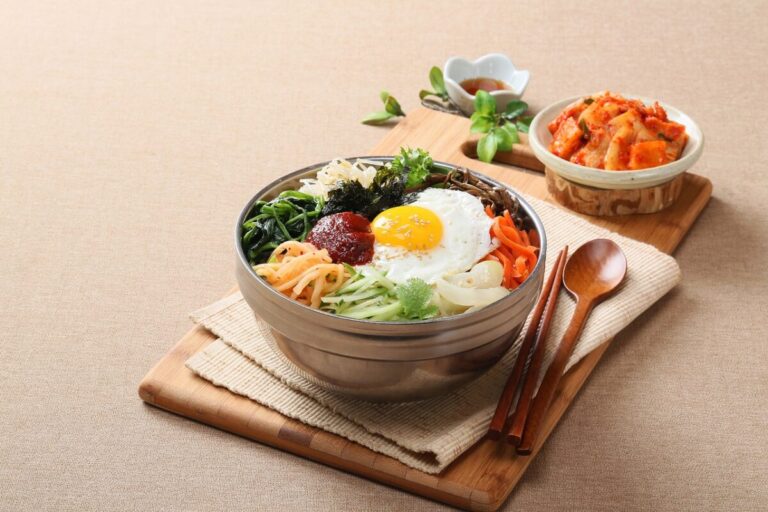
Bibimbap is a versatile and visually appealing dish that represents the rich cultural heritage of South Korea. Read on for the fascinating facts surrounding bibimbap, exploring its origins, ingredients, and how to make it at home.
Our team at Remitly created this guide as part of our series that celebrates the traditional dishes of our global customers.
The Origins of Bibimbap: A Journey through Korean Food History
Bibimbap dates back to early rural Korea. It’s thought to have started with farmers who mixed rice with various vegetables and meat to use up leftover ingredients. Other historians believe it may have its origins in religious rituals.
Regardless, the dish is centuries old. Bibimbap was first recorded by a scholar during the Joseon Dynasty between the late 1500s and mid-1600s. Since then, multiple published works have referenced or described bibimbap.
The popularity of bibimbap grew in the 20th century when Korean cuisine began gaining international recognition. Today, it’s a staple of Korean restaurant menus.
South Korea’s Traditional Rice Bowl
Bibimbap is typically served in a hot stone bowl, which helps to keep the rice and ingredients hot. The ingredients are arranged in an aesthetically pleasing manner, with each component adding its unique color and flavor to the dish.
The beauty of bibimbap lies in its versatility. The dish can be customized to suit individual tastes and preferences. The most common ingredients used in bibimbap include carrots, bean sprouts, spinach, mushrooms, and beef or tofu.
Gochujang Sauce: The Spicy Heart of Bibimbap
Gochujang sauce is an essential ingredient in bibimbap. It’s a savory chili paste made from red chili peppers, glutinous rice, fermented soybeans, and salt. The sauce is a staple in Korean cuisine and can be found in many traditional dishes.
Recipe: Traditional Korean Bibimbap
Ingredients:
- 2 cups cooked short-grain rice
- 1 carrot, julienned
- 1 cup bean sprouts
- 1 cup spinach
- 1 cup mushrooms, sliced
- 200g beef, thinly sliced (or substitute with tofu for a vegetarian option)
- 2 tablespoons soy sauce
- 1 tablespoon sesame oil
- 2 cloves garlic, minced
- 4 tablespoons gochujang sauce
- 2 tablespoons vegetable oil
- Salt, to taste
- Sesame seeds, for garnish
- Fried egg (optional)
Instructions:
- In a bowl, marinate the beef (or tofu) with soy sauce, sesame oil, minced garlic, and a pinch of salt. Set aside for 10-15 minutes to allow the flavors to meld.
- Heat 1 tablespoon of vegetable oil in a pan over medium heat. Add the marinated beef (or tofu) and cook until browned and cooked through. Remove from heat and set aside.
- In the same pan, add another tablespoon of vegetable oil and sauté the carrots, bean sprouts, spinach, and mushrooms separately until each is tender. Season each vegetable with a pinch of salt while cooking. Remove from heat and set aside.
- To assemble the bibimbap, divide the cooked rice into individual serving bowls. Arrange the cooked vegetables and beef (or tofu) on top of the rice in separate sections.
- Place a spoonful of gochujang sauce in the center of the bowl. If desired, top with a fried egg.
- Sprinkle sesame seeds over the bibimbap for garnish.
- To eat, mix all the ingredients together, ensuring that the gochujang sauce is evenly distributed.
Note: Feel free to customize your bibimbap by adding or substituting other vegetables or proteins according to your preference. You can also adjust the amount of gochujang sauce to suit your desired level of spiciness.
Learn More About South Korean Cuisine
South Korean cuisine is a treasure trove of flavors and culinary traditions. From spicy stews to savory pancakes, the cuisine of South Korea offers a wide range of dishes. These include:
Kimchi: No discussion of South Korean cuisine would be complete without mentioning kimchi. This traditional side dish is made from fermented vegetables, most commonly cabbage, and is known for its spicy and tangy flavor.
Bulgogi: Bulgogi is a popular Korean dish made from thinly sliced marinated beef that is grilled or stir-fried. The beef is typically marinated in a mixture of soy sauce, sugar, garlic, and sesame oil, which gives it a sweet and savory flavor.
Japchae: Japchae is a stir-fried noodle dish made from sweet potato noodles, vegetables, and meat. The noodles are cooked until they are soft and chewy, and then tossed with a soy sauce-based sauce.
Tteokbokki: Tteokbokki is popular street food in South Korea. Koreans make it from rice cakes cooked in a spicy sauce made from gochujang, soy sauce, and sugar.
Visit the homepage, download our app, or check out our Help Center to get started.
